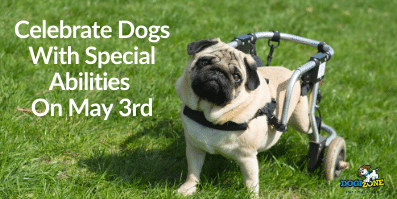Celebrate Dogs With Special Abilities On May 3rd
One of the amazing things about dogs with special abilities is they can adjust to a wide range of different situations, including physical differences that may be present from birth or those that develop later in life. These special dogs can make excellent pets, and they find ways to overcome their physical differences in ways that are truly inspirational.

To care for dogs with special abilities, there some basic modifications that a dog owner needs to consider. These help to keep the dog safe, while also maximizing the freedom the dog has to enjoy life as a puppy through to a senior dog.
Blindness and Vision Loss
Dogs with special abilities can have hereditary conditions or congenital conditions that result in blindness from birth or blindness as the dog ages. Most breeds of dogs and mixed breeds can develop conditions like PRA or Progressive Retinal Atrophy, which is a condition that will eventually cause full blindness. It is not painful, and the dog’s experience no discomfort, with most dogs adjusting well to the gradually diminishing range of vision.
Blind dogs do well in familiar locations. Avoid moving furniture or changing landscaping to help the dogs stay in a familiar location. These dogs need to be kept in a securely fenced area or on a leash when outdoors. Routines, consistency, and the use of verbal reassurance in new situations is critical for these dogs to feel comfortable and reduce anxiety.
Dogs that are blind from birth can be trained using scent lures for cues as well as gentle, verbal cues. Like all puppies, they require consistency in training and lots of positive attention. Clicker training can be very effective for these dogs.
There are special types of safety equipment for blind dogs, including a halo collar. This provides a lightweight, rigid rod that creates a halo around the dog’s head and is attached to a harness and neck support. The halo bumps into objects before the dog’s head makes contact.
Deaf and Hard of Hearing Dogs
Like blindness, deafness in dogs can be present from birth, or it may develop over time. Issues such as chronic ear infections and neurological conditions can also cause loss of hearing, as can trauma to the head.
Dogs that are deaf also need to be kept in a secure outdoor location or walked on a leash. This is for their safety, particularly when traffic is a consideration. Deaf dogs can be trained using hand signals, and dogs can quickly learn hand signals for come, sit, stay, down, and even more complex tricks and commands.
Use food rewards or scent lures to attract the dog’s attention during the initial training program. A flashlight can also be used to draw the dog’s attention, particularly when paired with a scent lure and food reward in the initial training.
Mobility Issues
Dogs with missing limbs or non-working limbs may need assistance with mobility and movement. There is a range of different options in accommodations for these dogs, including braces, wheeled support for the dog’s body, and even in the use of prosthetic limbs for dogs. Training the dog with the prosthetic limb or device requires regular, positive training to allow the dog to become comfortable with the device.
It is also important to keep in mind that dogs can adjust to the loss of a limb. There are specialized training programs for “tripod dogs,” which help the owner to understand how the dog moves and how training can be designed to match the natural body movement created by the missing leg.

